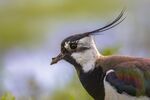 Is a wader from the family of Charadriidae. Most distinctive, easy to recognize and relatively common in wet meadows.
Is a wader from the family of Charadriidae. Most distinctive, easy to recognize and relatively common in wet meadows.
The top of the head and the wing of the Lapwing are very dark, almost black, yet they shimmer beautifully in shades of green and blue with rainbow reflections. Also in this case males and females look the same – except for the tip of the feathers on the head, which is slightly longer in males. It is difficult to distinguish between the sexes on this basis, especially in the field. The silhouette of this bird is very distinctive when in flight – it looks a bit like a large, black and white butterfly that alternately rises and dives, turning in flight while striking with its wide contrasting wings.
They can be recognized from a distance by their distinctive broad wings when they move in large flocks in early spring or fall. If we add to this information that the first individuals appear in Poland as early as February, it can be qualified as a harbinger of spring in the meadows and fields along the Narew River.
Like the sandpipers, it nests in wet meadows, on the banks of water bodies and in cultivated fields. Young Lapwings can sometimes be spotted in the grass, in mid-June, as they run on their disproportionately long legs.
Lapwing's food is small invertebrates, it feeds on exposed ground or in low vegetation collecting food from the ground. It is comfortable on flat ground so that it can observe its surroundings.
Lapwings overwinter in Western Europe, in the Mediterranean, they do not travel further south. Abundant and easy to observe in river valleys, yet its numbers are in steep decline: in the last 30 years, the population of lapwings has declined by nearly 50%.
